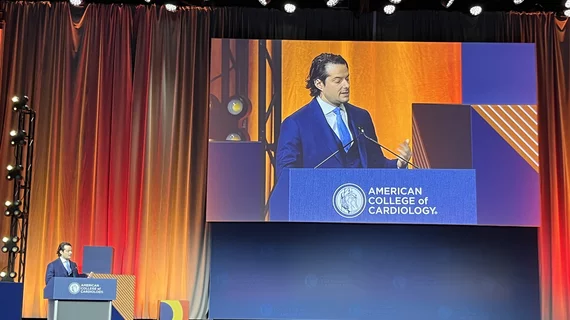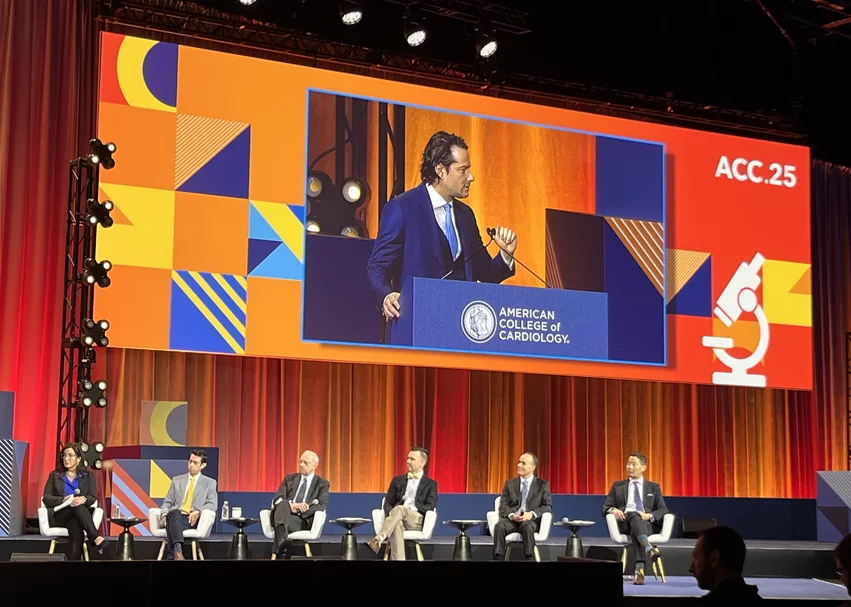New TAVR research explores adverse outcomes, disease progression in patients with asymptomatic severe AS
At ACC.25, the annual conference of the American College of Cardiology, researchers presented two key follow-up studies focused on data from the EARLY TAVR trial.
Each analysis provided additional insights about the potential benefits of treating asymptomatic severe aortic stenosis (AS) with transcatheter aortic valve replacement (TAVR) as opposed to clinical surveillance (CS).
A bit of context about EARLY TAVR
EARLY TAVR was a randomized controlled trial comparing TAVR with a balloon-expandable Sapien valve from Edwards Lifesciences with CS in 901 patients. The mean patient age was 75.8 years old, 69% were men and the mean Society of Thoracic Surgeons risk score was 1.8%. While a vast majority (83.6%) of patients faced a low surgical risk, the mean Kansas City Cardiomyopathy Questionnaire (KCCQ) score was 92.7, suggesting the cohort presented with a relatively healthy, symptom-free quality of life. All CS patients were followed closely and converted to TAVR as soon as the first signs of clinical symptoms were identified.
The study’s primary endpoint—a composite of all-cause mortality, stroke or unplanned cardiovascular hospitalizations—was seen in 26.8% of TAVR patients and 45.3% of clinical surveillance patients. This was primarily driven by a significant reduction in unplanned hospitalization—20.9% for TAVR, 41.7% for CS—though early treatment was also associated with lower rates of all-cause mortality (8.4% vs. 9.2%) and stroke (4.2% vs. 6.7%).
Data from EARLY TAVR were presented by lead investigator Philippe Généreux, MD, director of the structural heart program at Morristown Medical Center’s Gagnon Cardiovascular Institute, at TCT 2024 and simultaneously published in The New England Journal of Medicine.[1]
“Given the benefits observed and the lack of harm, early TAVR may be preferred to clinical surveillance in patients with asymptomatic severe AS, especially when combined with the challenges of timely symptom recognition and prompt treatment in real-world settings,” Généreux said at the time.
What we learned at ACC.25
The first EARLY TAVR subanalysis at ACC.25 focused on patients who were originally just being watched with CS, but then developed symptoms and ended up undergoing TAVR. The goal was to learn how waiting before the eventual aortic valve replacement impacted patient outcomes—did that initial period of watchful CS do harm to the patient’s heart?
The study’s authors compared 444 patients who underwent TAVR right away with 388 patients who underwent delayed AVR after an initial period of CS. Overall, the study’s primary outcome—a composite of death, stroke or heart failure hospitalization after two years—was seen in 10.6% of delayed AVR patients and 6.8% of early TAVR patients. This was primary driven by a higher periprocedural stroke rate (1.8% vs. 0.9%) in addition to higher stroke rates after one year (2.6% vs. 1.4%) and after two years (4.5% vs. 2.7%).
All-cause mortality and heart failure hospitalizations were also more common following delayed AVR.
Généreux presented these findings, noting that patients who underwent delayed AVR were much more likely to experience an adverse outcome if classified with acute valve syndrome, which the team defined as New York Heart Association III or IV heart failure, ventricular arrhythmia, syncope, atrial fibrillation, left ventricular ejection fraction less than 50% or other significant complications.
It is these patients who go on to develop acute valve syndrome, it seems, who would benefit the most if treated with TAVR right away as opposed to waiting for the development of symptoms.
“These findings provide a strong rationale for prompt intervention in patients with asymptomatic severe AS, at least to prevent progression to acute valve syndrome and poor outcomes,” Généreux said.
Is TAVR ‘inevitable’ in patients with asymptomatic severe AS?
Robert O. Bonow, MD, a cardiologist with Northwestern Medicine and editor-in-chief of JAMA Cardiology, was a panelist on stage for Généreux’s presentation. He said one of the primary lessons of this research is just how important it is to always closely follow-up patients with asymptomatic AS, because you never know when it may be time to treat.
Bonow also noted the almost “inevitable” nature of valve replacement with this patient population.
“You don’t gain much in waiting,” he said. “The question is, can you lose something in waiting? That’s what your current data show us.”
Bonow also asked Généreux about what may be behind the higher stroke rate in patients who did not undergo TAVR right away.
“That is a very important question,” Généreux said. “The first time I saw the data, I was very shocked about these findings.”
Généreux then told Bonow and the ACC.25 crowd that he wondered if AS was perhaps a risk factor for stroke. If performing TAVR on patients with asymptomatic severe AS right away can potentially reduce their periprocedural stroke risk, he added, it represents another benefit of early treatment.
Tracking biomarkers offers little guidance
The other EARLY TAVR subanalysis focused on tracking specific biomarkers in asymptomatic AS patients. The findings were presented at ACC.25 and simultaneously published in Circulation.[2]
The study’s authors measured N-terminal pro-B-type natriuretic peptide (NT-proBNP) and high sensitivity cardiac troponin T (hs-cTnT) to see if these biomarkers could help clinicians identify patients who would benefit more from immediately undergoing TAVR if they present with asymptomatic severe AS.
Overall, higher NT-proBNP and hs-cTnT levels were “broadly associated” with an increased risk of a poor outcome, suggesting they do not necessarily offer much value when it comes managing the timing of TAVR in these patients.
These findings underscore the unpredictable nature of AS, and the study’s authors concluded that the benefits of early TAVR are consistent “regardless of baseline biomarker levels.”
Edwards Lifesciences shares its perspective
Edwards Lifesciences funded both EARLY TAVR and these follow-up studies.
“We remain committed to advancing high-quality science and delivering life-saving structural heart therapies for patients with our leading Sapien valve platform, which has been used to treat more than one million patients worldwide,” Larry Wood, the company’s corporate vice president and group president of TAVR and surgical structural heart, said in a statement.


